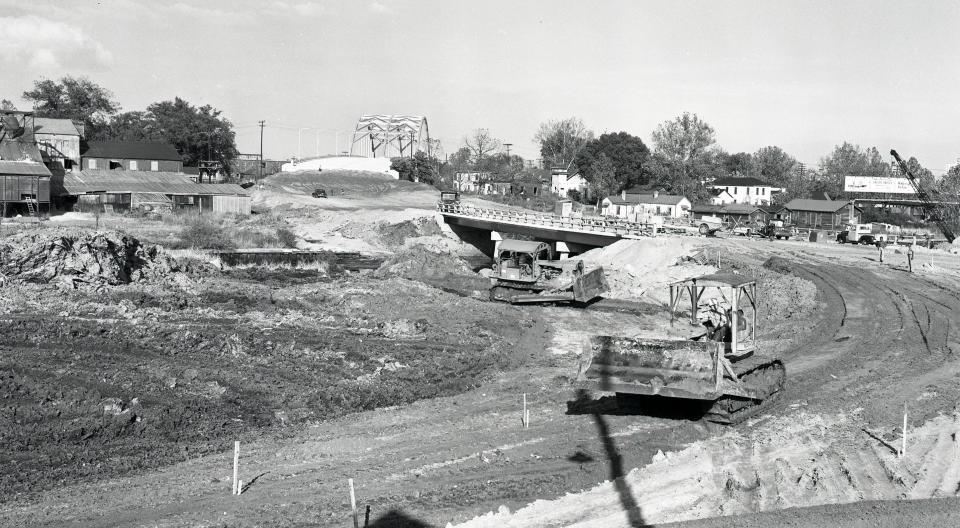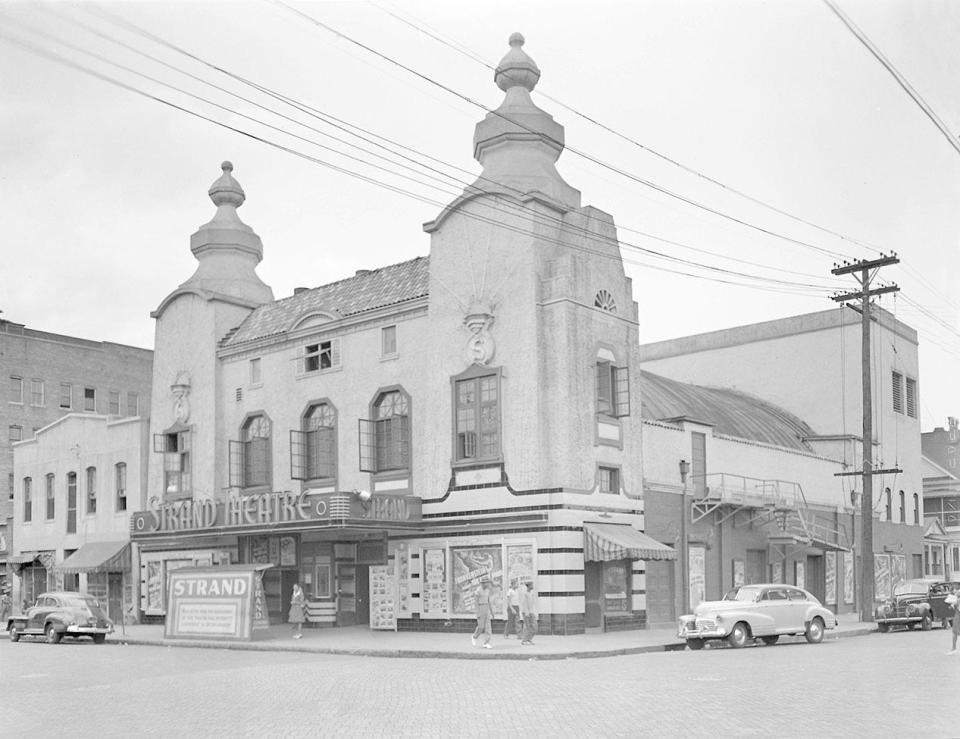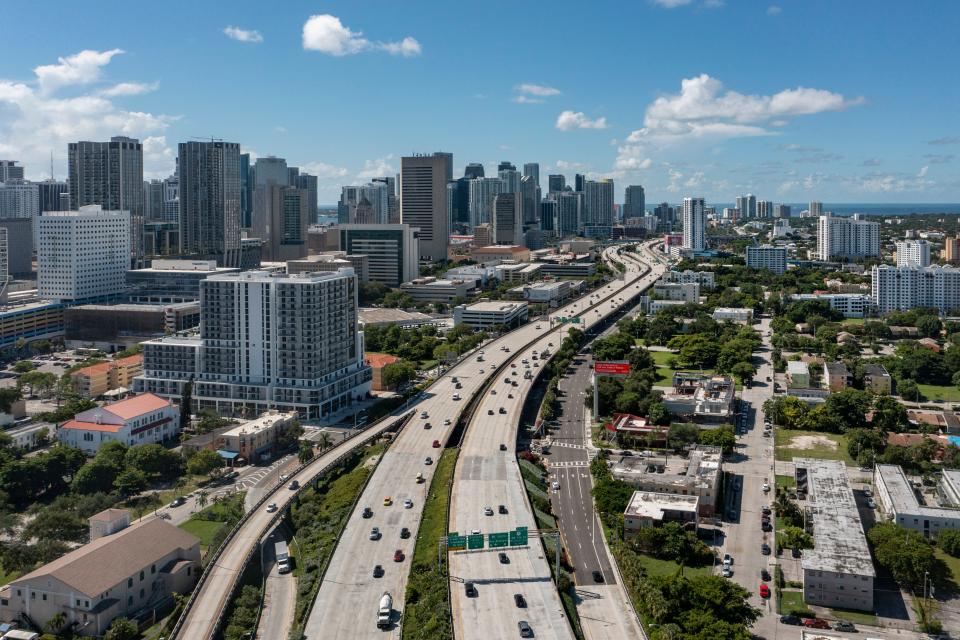Mark Woods: A thriving neighborhood before I-95, now a reminder that a road isn't just a road
- Oops!Something went wrong.Please try again later.
Fifteen years ago, as part of a project about Jacksonville’s homicide rate, we decided to tell the story of one block.
It was hard to declare any one block as the most dangerous in Jacksonville. There were, unfortunately, quite a few in the running. So we picked an area that had the highest number of felony violence incidents during a three-year period. And I set out to tell the story of that neighborhood, just north of UF Health Jacksonville, near Interstate 95, with two apartment complexes dating back to the 1950s.
I spent several months talking with people who lived there — and people who had lived there in the past.
More Mark Woods: Jacksonville could copy what's happening on streets of Bogota
Confederate monument debate: History from the mouths and pens of those who put up monuments to Women of Confederacy
DeSantis' health choice: Who was that unmasked man? In Florida, that's our new surgeon general
When I met with some of the residents who had moved to other parts of town decades ago, they recalled how in the 1950s and 1960s it was at the heart of a thriving African-American neighborhood, a safe place where people didn’t think twice about putting money in a jar and leaving it outside for the milkman.

They had a drug store where they drank malts. Within walking distance, they had movie theaters, barbershops, a major grocery store, a seafood market, laundries, bakeries and more.
"Back then … it was a neighborhood, a complete neighborhood," one of them said.
When I went back to that neighborhood with some of them, I asked the obvious question: What happened?
There, of course, wasn’t one answer. They talked about drugs and guns. They talked about desegregation having some unintended consequences, like the eventual closing of the neighborhood school.
But they also pointed to one of the most dramatic things to happen to their neighborhood: the construction of the interstate.
It ran through the neighborhood, wiping out some of it, affecting all of it.
In the 1950s, many of Jacksonville’s most prominent African-Americans lived in Sugar Hill. It was a neighborhood with big, beautiful homes, many of which were demolished to make way for the highway. There was Wilder Park, with a branch library, a track, baseball diamond and community center. It was replaced by an interchange.

The two apartment complexes off of North Davis Street turned into something very different from what the former residents grew up there remember.
This isn’t just a Jacksonville story.
It’s an American story.
Which brings us to the $1.2 trillion infrastructure bill signed by President Biden on Monday, a comment from Secretary of Transportation Pete Buttigieg, and the reaction from Florida Gov. Ron DeSantis.
Buttigieg was asked if part of that money will be used to address modern-day infrastructure issues that stem from the infrastructure decisions of the past. He said it made sense to try to fix some of the results of the systemic racism in highway design.
This led to DeSantis and others mocking the very premise.
Roads aren’t racist, they said, tweeted and guffawed.
“I heard some stuff, some weird stuff from the Secretary of Transportation trying to make this about social issues,” DeSantis said. “To me, a road’s a road.”
When DeSantis went on Fox News, host Tucker Carlson said: “Roads can’t be racist anymore than toasters and sectional couches can be racist. They are inanimate objects. They’re not alive.”
They’re right. The actual roads aren’t racist. But to pretend that race wasn’t a part of the equation that led to America’s highways is to do something that seems to be happening a lot lately: Those who talk about preserving history often are really good at ignoring it.
A road’s a road. It just happens that when we built a lot of them, they dissected and often decimated certain neighborhoods.
Some of that can be traced to lower land costs. Some of it involved these neighborhoods not having the political clout to prevent it from happening. Some of it was indirect systemic racism. Some of it was quite direct.
In Alabama, the highways were used as weapons, pushing back against the Civil Rights movement. Before the state highway director got in trouble for skimming funds, he was pushing to have the interstate take a path through two churches that were involved in the Montgomery bus boycott, plus the home of Ralph Abernathy, Martin Luther King Jr.'s assistant.
A road’s a road.
In Atlanta, where it sometimes seems like the goal of their highway construction was to create epic traffic jams, historian Kevin Kruse has written the intent was crystal clear. There, and many other cities, the highways became tools against integration, a paved version of George Wallace's segregation now, segregation tomorrow, segregation forever
"Interstate 20, the east-west corridor that connects with I-75 and I-85 in Atlanta’s center, was deliberately plotted along a winding route in the late 1950s to serve, in the words of Mayor Bill Hartsfield, as ‘the boundary between the white and Negro communities on the west side of town,’” he wrote.
A road’s a road.
In Orlando, the residents of Winter Park pushed back against the idea of Interstate 4 running through their neighborhood. The highway was shifted to cut through Parramore, an African-American neighborhood with its own long and rich history.
A road’s a road.

In Miami, Overtown was a vibrant, long-standing neighborhood before it was sliced apart by Interstate 95, the Dolphin Expressway and the Midtown Interchange.
A road’s a road’s a road, until all those rides slice up a neighborhood to the point where it loses most of its businesses and 80 percent of its population.
The infrastructure bill will send a lot of money to Florida in the next five years — including $13.1 billion for roads.
It will help repair bridges, improve public transportation and enhance drinking water infrastructure.
As someone who keeps talking about making Jacksonville more walkable, I’m hoping it will help us become a better place to ride a bike or go for a walk.
It also could, and should, include addressing some of the lingering issues that can be traced to the infrastructure of the past — both what was built and what wasn’t built.
But to do that starts by acknowledging that for all the complexities of the past, there is a fairly simple truth.
A road isn’t just a road.
mwoods@jacksonville.com, (904) 359-4212
This article originally appeared on Florida Times-Union: Ron DeSantis fails to understand racism in road, highway construction

